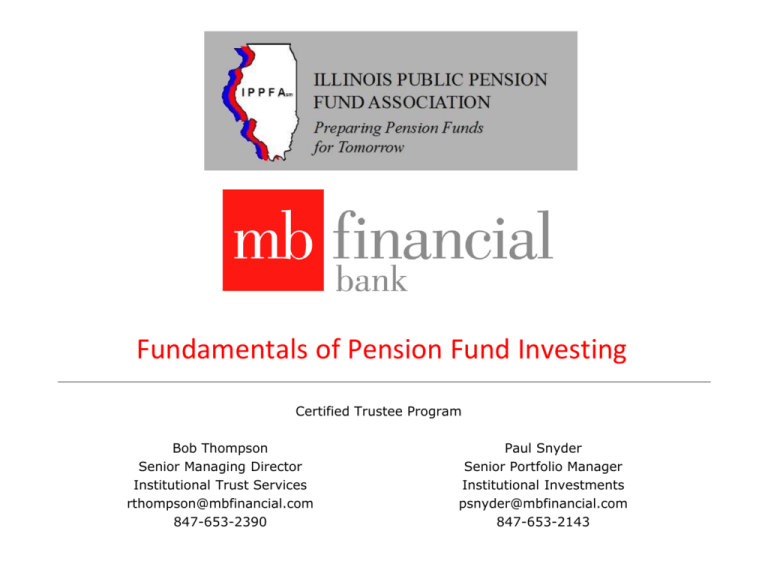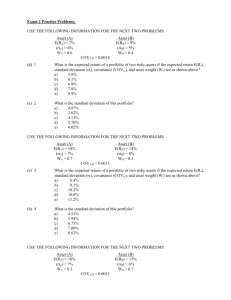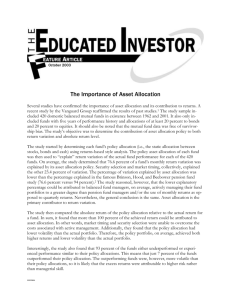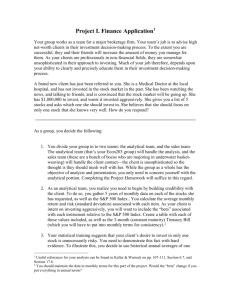
Fundamentals of Pension Fund Investing
Certified Trustee Program
Bob Thompson
Senior Managing Director
Institutional Trust Services
rthompson@mbfinancial.com
847-653-2390
Paul Snyder
Senior Portfolio Manager
Institutional Investments
psnyder@mbfinancial.com
847-653-2143
Agenda
•
•
•
•
•
Terminology Outline
Plan Administration
• Prudent Investor Rule
Investment Policy Outline - (Order is important)
Asset Allocation
• Risk & Return and related measures
• Parameters & Constraints
• Portfolio Construction
Conclusion
2
Post Retirement Benefits - Two Types
Defined Contribution Plan
Employer promises to provide
participants with certain
contributions or “matching”
contributions each period.
Defined Benefit Plan
Economic Risk
falls on Employee
Employer promises to provide
participants with a certain
pension amount at retirement.
Economic Risk
falls on Employer
401k, 403b
3
Plan Administration Terminology
Source: Investopedia.com
4
Plan Investment Terminology
Term
Definition
Source: Investopedia.com
5
Prudent Investor Rule
Uniform Prudent Investor Act (UPIA) An updated trust investment law that reflects the changes that have
occurred in investment practice since the late 1960s, specifically with regard to modern portfolio theory.
The Uniform Prudent Investor Act (UPIA) made five fundamental changes to the previous Prudent Investor Act
standard. The most important change was that the standard of prudence would henceforth be applied to any
investment in the context of the total portfolio, rather than to individual investments. Another key change was the
extension of permission to the trustee to delegate investment management functions, subject to appropriate
safeguards; such delegation was expressly forbidden by the former trust law.
By taking the total portfolio approach and eliminating category restrictions on different types of investments, the
UPIA fostered a greater degree of diversification in investment portfolios. It also made it possible for trustees to
include in their investments more non-traditional asset classes such as derivatives, commodities and futures.
While these investments individually have a relatively higher degree of risk, they could potentially reduce overall
portfolio risk and boost returns when considered in a total portfolio context.
Per Illinois Statute, there are restrictions on non-traditional asset class investing.
Diversification
Asset Allocation
Lower Volatility
Source: Investopedia.com
6
Higher Return Potential
Investment Policy Statement (IPS)
•
•
What is it?
A formal document that governs the investment decision
making, taking into account objectives and constraints of
the plan.
• Must be readily implemented by current or
future investment manager.
• Must promote long term discipline for
portfolio related decisions.
• Must help protect against short term shifts in
strategy when either market environments or
portfolio performance cause panic or
overconfidence.
7
IPS – Statement of Purpose (1)
What is it?
• Brief but concise description of the plan, plan
participants, plan beneficiaries and administrative
personnel.
• Should provide enough background information so that
any competent investment manager can gain a common
understanding of the overall state of affairs.
• Should include key factual data and identify any unique
parameters and constraints.
• No one size fits all
• No formal template or boiler plate
•
8
IPS – Statement of Responsibility (2)
What is it?
• Identify all related parties with their respective duties
and responsibilities. (investment manager, custodian,
trustees)
• Identify any regulatory or statutory mandates that must
be followed.
• Determine the means by which all parties are to be
measured/monitored.
•
9
IPS – Investment Objectives & Goals (3)
What is it?
• Objectives should focus on risk and return
considerations.
• Risk objectives are associated with the plan beneficiaries’
ability and willingness to take on certain risks.
• Examples:
• Required near term funding needs (liquidity)
• Existing financial strength (under funded??)
• Time Horizon
• Stated risk tolerances (volatility of no more
than 25% in any given year)
•
10
IPS – Investment Objectives & Goals contd (3)
•
Return objectives should be realistic, flexible and
commensurate with normal market conditions.
•
Should be consistent with Risk Objectives.
•
Differentiating between nominal and “real” returns
•
Should be viewed from a “Total Return” perspective
11
IPS – Investment Objectives & Goals contd (3)
•
What is it?
•
Goals should be used to achieve a balance that satisfies
both nearer term and longer term beneficiaries.
•
Benchmark indices should be identified
•
Quantifiable measures against such indices should be
identified. (compare apples to apples)
12
IPS – Investment Guidelines (4)
•
What is it?
•
Identification of asset classes that are to be used or
forbidden in constructing a portfolio:
• Fixed Income: US Government Bills, Notes, Bonds, Agencies, Municipals,
Corporates, TIPS, CD’s ……..what is the lowest acceptable credit quality???
Equities: Domestic and International Large Caps, Mid Caps, Small Caps
• Alternatives: Real Estate, Commodities
Benchmark indices should be identified for above
Quantifiable measures against such indices should be
identified. (compare apples to apples)
•
•
•
13
IPS – Investment Performance Review & Evaluation (5)
•
What is it?
•
Goal is to obtain information from investment
manager(s) to identify actual performance (Gross & Net
of Fees)
Determine if performance was derived within the
boundaries of the Investment Guidelines
Ascertain capital market expectations
Rebalance (if necessary) to targets given market
fluctuations.
Discussion of any proposed changes in the future.
•
•
•
•
14
The Importance of Asset Allocation
•
•
Goal is to develop an investment strategy that attempts to balance risk versus reward
by adjusting the percentage of each asset class according to the unique needs of the
pension fund.
In general, adding asset classes that offer returns that are NOT perfectly correlated
can reduce the overall risk in terms of the variability of returns.
15
Risk & Return: The Basics
•
Inherent trade off between return and risk.
16
Determining Asset Allocation Policy
Growth Oriented
Income Oriented
17
Identifying Acceptable Asset Classes
•
Expected Rate of Return
• Based on historical data
•
Risk Free Rate: The theoretical rate of return of an
investment with zero risk.
• Ex: Short term Treasury Bills
•
Risk Premium: The return in excess of the risk free rate
that an investment is “expected” to yield. This is a form
of compensation for investors who are willing to tolerate
extra risk.
• Think of this as “hazard” pay (Haz Mat, SWAT etc..)
18
Identifying Acceptable Asset Classes
•
Expected Rate of Return
If Treasury bill rate = 2%
If the Risk Premium = 5.5%
Then the expected rate of return is as follows:
ER = RF + RP
?? = .02 + .055
.075 or 7.5% “Expected” return
19
Identifying Acceptable Asset Classes
Risk or Volatility
• Measured in terms of Standard Deviation
• Defined as a measure of the dispersion of a set of data from its
average or mean. The more spread apart the data, the higher the
deviation. Standard deviation is calculated as the square root of
variance.
•
20
Identifying Acceptable Asset Classes
Which asset class has more risk in terms of volatility?
21
Identifying Acceptable Asset Classes
•
•
•
•
•
•
•
Risk or Volatility contd (Beta)
A quantifiable number describing the relation of an assets
returns with those of the respective benchmark.
Beta is a useful measure used to describe the “relationship” of
returns over time.
A Beta of 1 is typically used as the respective benchmark return.
If the benchmark index has market volatility of 10%, a fund with
a beta of 1 should have the same 10% volatility.
If the benchmark index has market volatility of 10%, and your
fund moved 15%, the Beta of this fund would be 1.5.
If the benchmark index has market volatility of 10%, and your
fund moved 8%, the Beta of this fund could would be 0.8.
22
Identifying Acceptable Asset Classes
•
•
•
•
Risk or Volatility contd (Beta)
Ex: The S&P 500 returned +12% in the past year. ABC fund has
historically had a Beta of 1.3.
Should the return of ABC fund be <12%, =12%, >12%?
If ABC fund had a Beta of 1.3 relative to the S&P 500 in the above
example what should you expect the return to be?
• S&P 500 return = 12%
Fund Beta = 1.3
•
ABC fund return @1.3 Beta = (12%*1.3) =15.6%
•
In dollar terms: $1000 invested in S&P 500 would return
$1120 in one year. $1000 invested in ABC fund would return
$1156.
23
Relationship of Investment Risk & Return (Correlation)
In a perfect world
24
Relationship of Investment Risk & Return (Correlation)
Trend is upward
sloping
• The real world
•
Trend is downward
sloping
• The real world
•
25
Determining Asset Allocation Policy (Weighting Constraints)
A brief (very brief) summary of Illinois Pension Code (40
ILCS 5/1-113)
• If pension fund assets <$2.5 million, then equity must
not exceed 10%. (separate/mutual funds)
• If pension fund assets >$2.5 million, then equity must
not exceed 45%. (separate/mutual funds)
• If pension fund assets >$5 million, then equity must not
exceed 45%. (separate/mutual funds individual equities
via investment manager)
• If pension fund assets >$10 million, then equity must not
exceed 50%. ***Changes in 2011 & 2012***
• What about Fixed Income (bonds)???
•
26
Determining Asset Allocation Policy (Time Constraints)
•
Plan participants are the ultimate beneficiaries of the
plan assets…..NO MATTER WHAT!!!
•
Time horizons are typically perpetual for pension funds
•
Working with the actuaries can provide some guidance
to your specific plan.
27
Determining Asset Allocation Policy (Investment Goals or Target Returns)
•
Realistic Expectations based on recent market history
and a similar interest rate environment.
28
Ibbotson® SBBI®
Stocks, Bonds, Bills, and Inflation 1926–2010
$16,055
$10,000
$2,982
Compound annual return
• Small stocks
• Large stocks
• Government bonds
• Treasury bills
• Inflation
1,000
12.1%
9.9
5.5
3.6
3.0
$93
100
$21
$12
10
1
0.10
1926
1936
1946
1956
1966
1976
1986
1996
Past performance is no guarantee of future results. Hypothetical value of $1 invested at the beginning of 1926. Assumes reinvestment of income
and no transaction costs or taxes. This is for illustrative purposes only and not indicative of any investment. An investment cannot be made directly in
an index. © 2011 Morningstar. All Rights Reserved. 3/1/2011
2006
Ibbotson® SBBI®
Stocks, Bonds, Bills, and Inflation 1991–2010
$20
Compound annual return
• Small stocks
• Large stocks
• Government bonds
• Treasury bills
• Inflation
10
$12.57
13.5%
9.1
8.4
3.5
2.5
$5.75
$5.05
$1.97
$1.64
1
0.60
1991
1996
2001
2006
Past performance is no guarantee of future results. Hypothetical value of $1 invested at the beginning of 1991. Assumes reinvestment of income
and no transaction costs or taxes. This is for illustrative purposes only and not indicative of any investment. An investment cannot be made directly in
an index. © 2011 Morningstar. All Rights Reserved. 3/1/2011
Stocks, Commodities, REITs, and Gold
1980–2010
$100
Compound annual return
• REITs
• U.S. stocks
• International stocks
• Commodities
• Gold
12.3%
11.4
10.1
7.5
3.2
$36.02
$28.08
$19.98
$9.35
10
$2.68
1
0.50
1980
1985
1990
1995
2000
2005
Past performance is no guarantee of future results. Hypothetical value of $1 invested at the beginning of 1980. Assumes reinvestment of income
and no transaction costs or taxes. This is for illustrative purposes only and not indicative of any investment. An investment cannot be made directly in
an index. © 2011 Morningstar. All Rights Reserved. 3/1/2011
2010
Conclusion
•
Questions & Answers
•
Quiz
32







